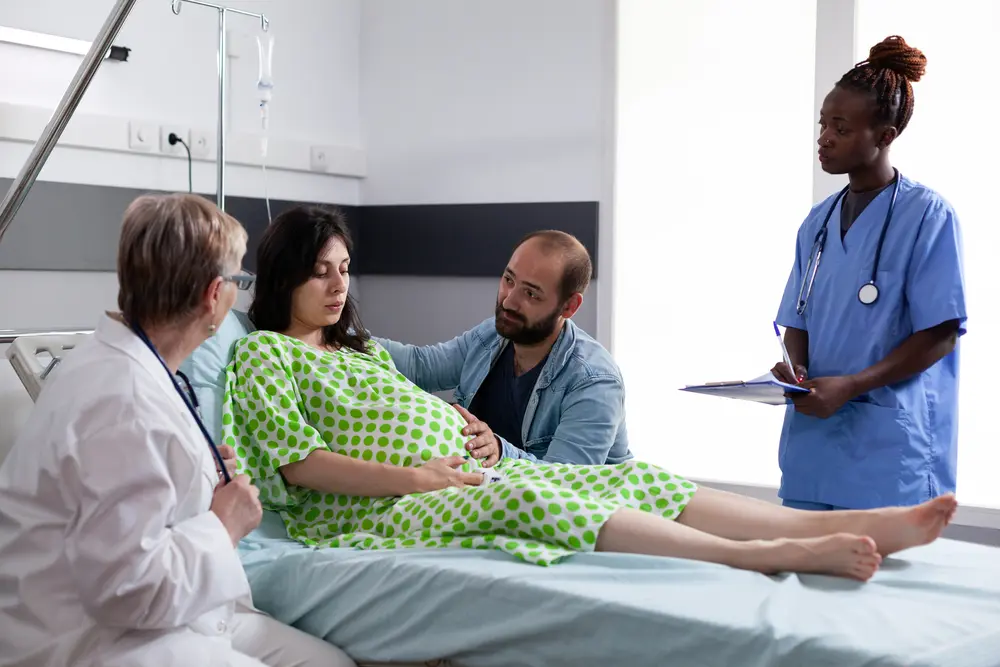Paralyzed pregnant women face additional challenges in pregnancy, one of which is that they might not recognize the signs of labor, particularly in women with T10 or higher injuries.
This is because the pain in the initial stage of labor is transmitted by the spinal segments T10 to L1 of the nervous system in the body, which are damaged in this level of spinal cord injury.
While the intensity of these pain sensations may vary depending on the extent of paralysis, some women with spinal cord injuries have reported feeling discomfort or even pain during labor or other signs of something going on, like mild stomach pain, muscle spasms, a stuffy nose, a slight rise in blood pressure, or even autonomic dysreflexia.

Pregnancy in women with spinal cord injury
Women usually resume their menstrual cycle within a year of injury, which has no effect on fertility and allows them to get pregnant just as quickly as before. A new study suggests that women with SCI continue to be reproductive and have an equal probability of conceiving.
People who want to start a family should consult an obstetrician before becoming pregnant to ensure they do not have any underlying health conditions that might hinder fertility. This is because a spinal cord injury increases the risk of urinary tract infections (UTIs) and their effects, which are manageable on their own but affect prenatal care, childbirth, and postnatal care.
Now that you have conceived, there are certain things to watch for, just like any other healthy pregnancy in other women without paralysis.
Pre-Delivery Checkups
Unrecognized labor occurs more frequently in women with spinal cord injuries. There is also evidence that these women are more likely to contract premature labor.
Two issues of greater risk are associated with early birth in such cases. Preterm newborns may have potentially fatal developmental or physiological problems.
That is why some researchers have suggested that after 28–32 weeks, women should be monitored 1–2 times per week, be on total bed rest with specific attention to the bladder, bowel, and skin, and be hospitalized early for an evaluation of effacement and dilatation.
There’s a chance you’ll need to use a home contraction monitors as well. And if there is a probability of premature labor, she must be informed by the delivery department and hospitalized accordingly.
Women are also advised to verify the facilities’ ease of access and suitability by viewing the patient rooms, delivery rooms, and the like. She should communicate her requirements to the hospital staff in advance.
Labor and delivery

It might be difficult for pregnant women with spinal cord injuries to predict when they will go into labor or when labor starts.
Braxton Hicks contractions are the uterus’s way of getting ready for labor and birth. It’s possible to feel a contraction as a tightening in the lower abdomen or as discomfort in the back. They can also be felt by touching the stomach. These muscle contractions might not be felt if the damage is above the T10 level.
Early Braxton Hicks contractions or muscle spasms, if experienced, may come and go in the uterus as labor progresses.
Other symptoms that can be felt in pregnant women with physical disabilities are,
- Water leaks or mucus discharge
- Feelings of worry and anxiousness
- Diarrhea
- Persistent, powerful contractions
- Unusual backache or pain
- Abdominal constriction
- Pressure in the pelvic regions
Loss of feeling and alterations in muscle tone following a spinal cord injury can also accelerate the delivery process compared to a woman without paralysis, which goes more quickly and with less discomfort. This can explain why the body’s muscles offer little resistance and labor, and delivery is often quick.
Water breaking or discharge and mild discomfort are also present but are unnecessary when labor starts. Sometimes there are no clues provided by the body. However, if the injury is below T12, the labor contractions will be normal, just like in other women.
If any other complications develop, they often impact the mother instead of the infant.
Psychological Impact of Labor
During delivery, a woman with a spinal cord injury may experience a loss of control. Anxiety and a need for control are prevalent near the end of pregnancy, and they are worsened by unfamiliar surroundings, fear of the unknown, and uncertainty.
Delivery Method
Contrary to popular opinion, natural childbirth is the most common delivery method, with Cesarean sections reserved for women with SCI who experience complicated pregnancies.
Data from the most recent year shows that 77% of births occurred by vaginal delivery, 14% via instrumental delivery, and 23% via cesarean section.
Other recent research and data support the idea that pregnancy outcomes are typically positive and that most women, regardless of the severity of their spinal cord injury, can have a safe and healthy vaginal birth.
Vacuum extractions, forceps, and anesthetics can be used to help the delivery process if the mother’s abdominal muscles aren’t strong enough to push the baby out.
Other methods, such as cesarean sections or C-sections, are surgical procedures that can be done instead of natural birth. Instead of the baby being born through the birth canal, this surgical procedure includes an incision along the pubic line.
Constant monitoring is required with a multi-disciplinary approach.
Complications in Labor and delivery
Some medical complications may arise after giving birth.
Autonomic Dysreflexia
Pregnant women with a spinal cord injury (SCI) above the T6 level face an increased risk of developing autonomic dysreflexia during active labor and delivery. Almost 85% of pregnancies with spinal cord injuries have reported autonomic dysreflexia.
Inducing pain during childbirth might lead to autonomic dysreflexia, which can be deadly for the mother.
The symptoms include a terrible headache and high blood pressure that coincide with the onset of uterine contractions. The woman may also feel cold chills and profuse sweating, and her heart rate may slow down (or speed up, on rare occasions).
Epidural anesthesia, a pain treatment method, may be used to prevent AD. Even though she may not be able to feel the contractions, a woman with total damage to the spinal nervous system may benefit from the epidural anesthetic, which is usually considered essential by obstetricians.
Some women with SCI in pregnancy may be anxious that an epidural would cause more spinal cord injury; however, this is relatively uncommon, with an incidence of 0.02%.
Blood Loss and Anemia
Numerous studies have shown that pregnant women with spinal cord injuries have an increased chance of developing anemia, even post-delivery. Iron supplements can be prescribed to women, and IV therapy can also be given to paralyzed mothers for emergency treatment in the delivery room.
Low Lung Volume
Lung capacity is usually low in normal pregnancies. Still, if the lung capacity is also impaired due to a spinal cord injury, it may be prudent to administer brief oxygen supplementation during delivery.
Positioning
Post-spinal cord injury physical changes may influence the positioning of the patient during labor and delivery. Deformities in the pelvis and spine, such as scoliosis, hip disarticulation, contractures, heterotopic ossification, or previous fractures, may hamper the baby’s descent.
Regardless of the cause, these changes to the woman’s body make it more difficult to place her in the appropriate position on the delivery table and sliding board.
Urinary Tract infections
A urinary tract infection (UTI) during pregnancy can cause serious complications such as preterm labor, low birth weight, and even paralysis of the baby. Urinary tract infections are one of the most common infections among pregnant women, and if left untreated, they can lead to serious health problems.
It can be managed with intermittent catheterization. Women who use intermittent catheterization will likely need to catheterize more frequently or switch to a Foley catheter post-delivery.
Blood clots
Since both a spinal cord injury and pregnancy can make it more likely for blood to clot, blood-thinning medicines are often given to keep a pregnancy healthy.
Some postpartum women may need to keep taking blood thinners, depending on the severity and level of injury and the mother’s health.
Pressure Ulcers
Pressure ulcers are more likely to develop when the blood count is low or hormone balance shifts. In pregnancy, it can develop with weight gain and is at greater risk of developing even postpartum.
According to one study, only 6% of pregnant women with spinal cord injuries developed pressure sores.
They are expected consequences of spinal cord injuries, although they are almost always avoidable with proper care.
Mattresses, pillows, and cushions designed to relieve pressure should be utilized during pregnancy and labor. It helps women who have trouble maintaining their balance in the trunk and may benefit from using extra cushions.
Breastfeeding
Medical journals advise breastfeeding women with high cervical lesions/injuries. (1)(2)
Yet, several studies concur that a spinal cord injury (particularly at or above T6) impacts breastfeeding and is associated with a shorter duration of breastfeeding. Many other factors can also affect it.
Women with SCIs who wish to breastfeed the baby and are physically able to do so may require additional assistance.
The baby’s placement is just one of several problems, including insufficient milk supply, autonomic dysreflexia, increased spasticity, breast infection, and so on.
Recommendations by Experts
Experts from the American College of Obstetricians and Gynecologists suggested the following for anyone interested in having a healthy and successful pregnancy:
- Women with spinal cord injuries who are considering getting pregnant should undergo a preconception examination.
- An obstetrician with experience caring for women with disabilities, maternal-fetal medicine subspecialists, anesthesiologists, spinal rehabilitation physicians, nurses, physiotherapists, occupational therapists, lactation consultants, pediatricians, and neonatologists should comprise a multidisciplinary team to manage pregnancy in women with SCIs.
- Care should be taken with autonomic dysreflexia, a potentially fatal consequence of SCIs that often manifests during labor. Repositioning the patient and eliminating or removing any stimulation are the first steps to prevent AD.
- Postpartum depression is natural, even in the case of spinal cord injury patients. Postpartum depression and other maternal mental health concerns need evaluation and treatment for this population.
Real-life experiences and a few suggestions from women with spinal cord injuries
Lacy Windham, a gynecologist, shares her opinion on delivery and labor pains, as lower spinal cord injury patients are less prone to complications. During labor, the uterus will continue to contract, and babies are often delivered via the forces of labor alone, without the mother pushing. Forceps or suction can be employed to hasten birth, while a cesarean section is reserved for typical reasons.
Vaginal birth is safe and preferable for most women. According to Emily, a gynecologist, having a child while living with a spinal injury is a “high-risk” situation for the mother. Nonetheless, this does not mean that being pregnant should be avoided at all costs. In other words, you should be extra careful to avoid and deal with any challenges that may arise.
Daniela, a person with quadriplegia by accident, shares her complete journey from pregnancy through labor and delivery in a series of videos. She is a mother of twins.
n the second part of the same video, Dani shares how her labor pains got complicated by a urinary tract infection, doctors opted for an abrupt C-section, and then she delivered her babies.
Paula talks about her pregnancy and labor. Her first pregnancy was tough; she had an episode of autonomic dysreflexia that doctors could handle well, and she had a healthy baby boy. Doctors also assisted her with her second delivery. The doctor and her team were already prepared, and a week before her due date, they admitted her to the hospital and started an IV with blood pressure-lowering medications. With the help of pre-labor assessment and treatments, she delivered another baby boy vaginally.
Another well-known case of Sandra Burton was mentioned in HuffPost. It was a complicated pregnancy with autonomic dysreflexia and blood pressure variations, but Sandra delivered two twin girls one by one within her care. Burton says that seeing her baby for the first time gave her the strength to get through the rest of the surgery.
Lizzy, another person with quadriplegia sharing her life on YouTube, also shared her labor story with her viewers. The video starts at 7 minutes, and like many other women, she also suffered from autonomic dysreflexia, but no labor pains were felt. Then she was efficiently managed by a team of doctors who helped her deliver a baby girl.
Conclusion
You don’t have to have a cesarean section (or C-section) just because you have suffered a spinal cord injury. In reality, most women can give birth vaginally, no matter how bad their injuries are. There are, however, considerations and risks to be kept in mind, just as in a normal pregnancy, such as bowel changes such as constipation, bladder changes such as urinary tract infections, pressure ulcers, and weight gain.
Before You Go
Fertility issues have always been a concern regarding spinal cord injuries. Most women with spinal cord injuries don’t realize that paralysis doesn’t typically cause infertility; only 12% of SCI women report infertility or trouble conceiving.
Learn about the changes that occur in pregnant women with spinal cord injuries.

